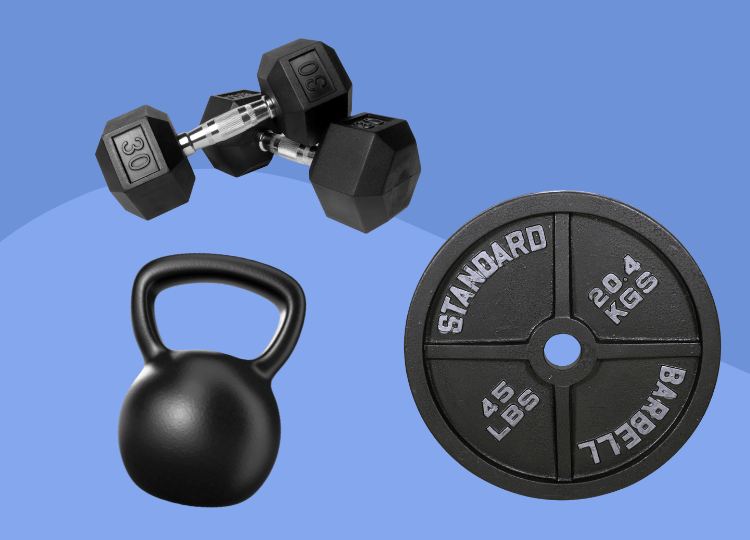Feeling intimidated by the free weights section is a common feeling amongst gym newbies.
With a wide selection of varying equipment, it can be confusing what type of weights are worth using and which weights are best suited to your fitness goals.
If your gym induction didn’t cover this… or alternatively, if you’re looking to buy some fitness equipment for your home, this guide outlines everything you need to know about different types of weights, including what they’re best suited for, benefits and potential drawbacks.
Is it just easier to stick with cardio equipment?
It can definitely be a bit overwhelming trying to get your head around the free weights section of a gym… but the benefits free weights and resistance training offers everyone is too good to ignore. Hopefully this gym equipment guide will help you feel more confident in what equipment to use, whether you’re in the gym or buying gear to use at home.
Selecting the Right Weight
Ultimately, regardless of the types of free weights you choose, the actual weight of the equipment is going to play a vital role in achieving your goals.
Light free weights will be better suited to HIIT and high-rep workouts. In contrast, heavy free weights will be better suited to strength and muscle-building workouts. If you’ve ever visited a gym equipment factory, you’d see firsthand how weights are designed for different training styles—from compact dumbbells perfect for fast-paced circuits to heavy-duty barbells built for serious lifting. Understanding this can help you select the right equipment to match your training needs.
At a Glance – Navigating Popular Free Weights at the Gym
- Dumbbells
- Barbells with Olympic Plates
- Kettlebells
- Medicine Ball
- Slam Ball
- Battle Ropes
- Sled
- Sandbags
What Do We Mean By “Free Weights”?
The term “free weights” is simply a term used to describe equipment that isn’t a “machine” – i.e., you can pick it up, move it, and usually, perform various exercises with it.
As we’ll discuss in this article, this includes things like dumbbells, kettlebells and the like.
Gym “machines”, usually describe things like the leg press machine, cable pulley station, and other stationary equipment. This equipment often isolates one specific muscle group.
One of the main benefits of using free weights is the need to stabilize the weight during the movement. Machines will provide rails and systems to provide safe movement, which usually removes the need to balance or stabilize the weight during the exercise.
This means free weights help improve balance and stability more than using machines and consequently, lead themselves better for functional training. You can do exercises that reflect real-world movements easier, and this is important for improving practical fitness to help support healthy ageing too.
Similarly, free weights open up more opportunity to do all sorts of movements and exercises. For example, apart from testing out different foot placements on a leg press machine, there’s not many other ways to use the machine. In contrast, there are literally hundreds of exercises and ways you could move a pair of dumbbells during a workout.
Types of Free Weights in the Gym (with Pictures)
Dumbbells

Dumbbells could well be our favourite equipment in the gym. Dumbbells provide a simple yet effective way to add resistance to all sorts of exercises and movements.
They’re a great option for beginners and allow you to just get started quickly.
Dumbbells are incredibly versatile and can be used in all sorts of ways. From using heavy dumbbells for a shoulder press, to selecting lighter dumbbells and doing tone and sculpt workouts, you’ll never get workout-boredom with dumbbells.
Our main advice for using dumbbells is firstly, to just go for it! Don’t feel scared to pick some up and start using them. Secondly, if in doubt, start light. Many seasoned weight lifters will still opt for very light dumbbells to warm up the muscles and get the body ready for heavier sets. Just because someone is lifting a lot of weight next to you, it shouldn’t put you off doing your own thing and starting with some light dumbbells and seeing how you get on.
Similarly, slowly increase the weight if you’re ready to up the resistance. Making big jumps in weight between sets when using dumbbells might mean you suddenly can’t complete the exercise in full.
Most dumbbell exercises will involve holding a dumbbell in each hand, which means you avoid one side of your body over-compensating for the other. You’ll also develop better stability and balance during any sort of lift too, compared to using a barbell, for example.
You can also use dumbbells on a bench to help support certain exercises like a dumbbell chest press.
Dumbbell Friendly Exercises:
- Renegade Row
- Shoulder Press
- Dumbbell Chest Flyes
- Sumo Deadlift
- Single Arm Bent Over Row
- Lateral Raise
Dumbbells = DB
Some fitness apps and workout programs will refer to dumbbell exercises as “DB”.
Our guide on the best dumbbells for women includes a selection of popular dumbbells ideal for home use. If you’re looking for free weights to buy, dumbbells will be cheaper than many other options (especially considering the versatility they offer).
Dumbbells come in a range of shapes, sizes and features. We’ve listed 3 of the common variations to the classic rubber dumbbells.
Hex
Hex dumbbells have 6 flat edges, which provides some additional benefits…namely, you can rest the dumbbells on the floor, without them rolling.
Beyond this just being convenient, it also opens up more exercises, such the devil press, renegade row, and dumbbell push-up.
Adjustable
Adjustable dumbbells are those where you can adjust the weight. These can either be all-in-one dumbbells, which are great for home use, or ones that use plates, whereby you can add or remove plates to make the dumbbells heavier or lighter.
Barbells with Weighted Plates
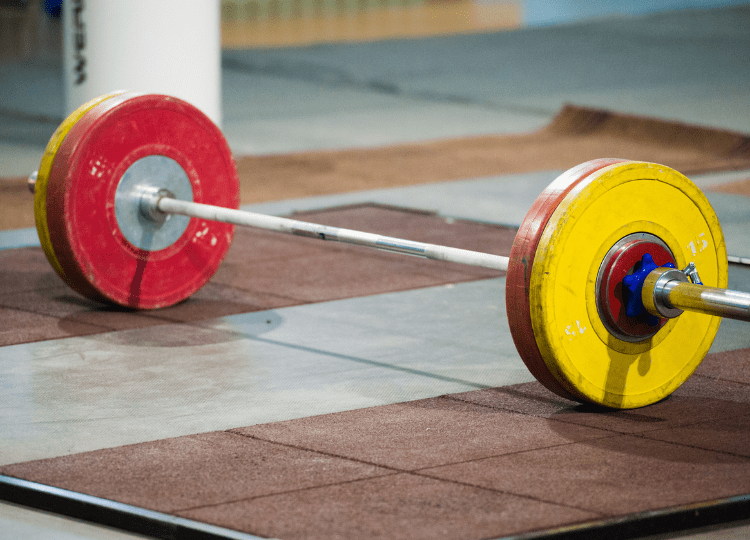
Arguably the most iconic piece of weight lifting equipment, the barbell (and accompanying plates) is the ideal solution for those looking to focus on power and strength.
Barbells make it easy to continuously load on more plates and up the weight (perfect for progressive overload training). This is a really effective way to build strength, power and muscle mass.
The barbell is probably the most popular choice for the big 3 compound exercises – deadlift, squat and bench press.
These exercises engage lots of muscle groups and together, you can actually train your whole body pretty effectively without adding in any other movements.
There’s absolutely nothing wrong with opting for lighter weights on a barbell, but traditionally, this equipment has been associated with heavier lifts. Whether you decide to go for light or heavy repetitions, the main thing to remember when using a barbell is that technique is incredibly important.
To add weight to a barbell, you can load up the required plates. Plates vary from gym to gym. Some gyms may opt for iron plates, but most modern gyms will use rubber plates.
Olympic plates are usually colour-coded, indicating the weight (Olympic plates get the name because they are the type of plates used in Olympic lifting).
Alternatively, other gyms may use barbells that come with handles for easy loading.
Barbell Friendly Exercises:
- Back Squat
- Deadlift
- Overhead Press
- Bent Over Row
- Bench Press
Barbell = BB
Some fitness apps and workout programs will refer to barbell exercises as “BB”.
You’ll see people use barbells on the bench press, squat rack and on the floor.
A Smith Machine is basically a barbell built into a squat rack. Although this somewhat restricts the natural movement (and so does draw criticisms), it does provide an effective way to get used to barbell exercises, so that might be an option if you’re a beginner.
If you’re buying a barbell for your home gym, you just want to ensure you’re buying plates that will fit the barbell you’ve selected. Most websites will make this very clear and most barbells are standard, but this is just something to be aware of. This is why we tend to opt for Olympic barbells and plates to standardize the size.
There are actually a few variations to the barbell, as discussed below.
Standard Straight Barbell
This is the regular, straight barbell. This is ideal for bench press, deadlifts and squats.
EZ-Bar
The EZ-bar is basically a type of bar designed predominantly for bicep curls. If you want to focus on your biceps, this will allow for a more natural grip when curling, as opposed to using a straight bar.
It also tends to be much shorter than a regular barbell.
Trap Bar
The trap bar is a variation popular for deadlifting. It puts less pressure on your spine compared to deadlifting with a regular straight bar and many say it is easier for beginners.
Thick Grip Bars
Thick grip bars are thicker than regular barbells. This is useful for those who want to improve their grip strength as they do compound lifts.
Kettlebells

Kettlebells have gained an almost cult-like following in recent years, with many opting for this type of free weight when exercising.
Kettlebells are popular in CrossFit workouts, and open up lots of different exercises to try. As well as developing functional strength, kettlebells can often lead themselves better to cardio HIIT workouts compared to using barbells, for example.
Kettlebell swings are probably the most iconic exercise for this equipment.
Where people go wrong with kettlebells is often just by selecting the wrong weight. Unless you’re experienced, you’re always better off opting for a light kettlebell to ensure your technique and form are correct.
Kettlebell Friendly Exercises:
- Goblet Squat
- Kettlebell Swing
- Kettlebell Row
- Kettlebell Straight Leg Deadlift
- Turkish Get Ups
The drawback to kettlebells is that certain exercises, like the kettlebell swing, really does need perfect technique… otherwise you risk injury. Also, if you’re buying for home use, you’ll need to decide what weight kettlebell to get, and if you actually would benefit from kettlebells of varying weights.
Medicine Ball
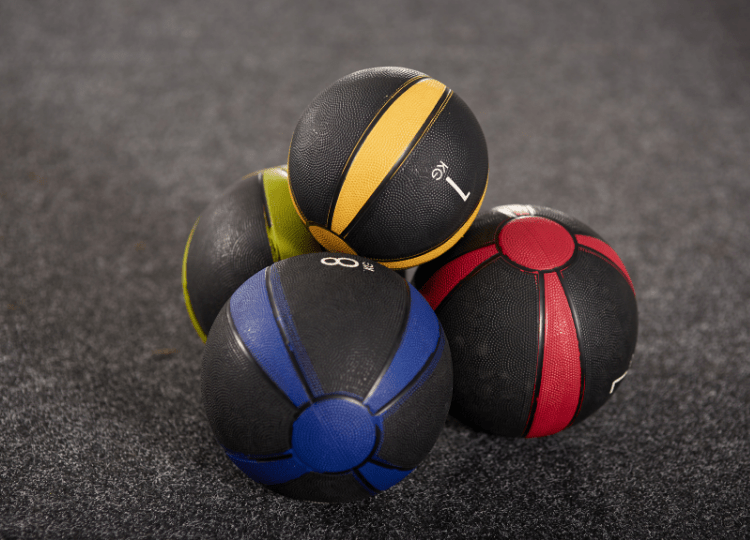
Medicine balls are another simple but effective piece of fitness equipment.
Medicine balls are basically heavy soccer balls – usually going up to 50 lbs.
Based on this weight limit, they don’t support the type of strength training exercises like barbells, dumbbells or kettlebells could. Instead, they are better for functional movements and rehab.
They can also help in training athletes, by improving strength as well as coordination and other ball skills.
Medicine Ball Friendly Exercises:
- Russian Twists
- Wall Balls
- Goblet Squats
As far as strength training goes, medicine balls are unlikely to be the main equipment used, but it could be something that you use to supplement some workouts, especially if you play sport and want to improve coordination and ball skills.
Slam Ball

Slam balls are a popular piece of functional fitness equipment and something you’ll see in circuit training and gyms like CrossFit and 45 Training.
They often look very similar to medicine balls but have one very clear objective… not to bounce!
This ability to prevent any bounce, means you can “slam” them on the floor… which makes for quite a fun and effective workout.
Slam Ball Friendly Exercises:
- Ball Slams
- Overhead Squats
- Squat Ball Throw
Battle Ropes

Battle ropes are quite a new addition to gyms, but well worth using if you’re into functional HIIT style workouts.
Battle ropes are basically just thick, heavy ropes. By looping them around a fixed point, you can perform all sorts of movements.
Although it may look quite straight forward to shake the rope in a “wave” motion, you’ll soon feel an almighty burn in your shoulders, arms and back.
Battle ropes are also often underrated and seen just for shoulder or HIIT workouts, but you can get very creative with them and target a variety of muscle groups. We often use them as a replacement for a slam ball… as you can “slam” them down on the ground without them bouncing up.
A few minutes using battle ropes will undoubtedly get your heart rate up and muscles fatigued… so if you’re short on time, this is a great piece of equipment to use.
Battle Rope Friendly Exercises:
- Jumping Rope Slams
- Coordinated Arm Waves
- Alternating Waves
- Wide Circles
Sled
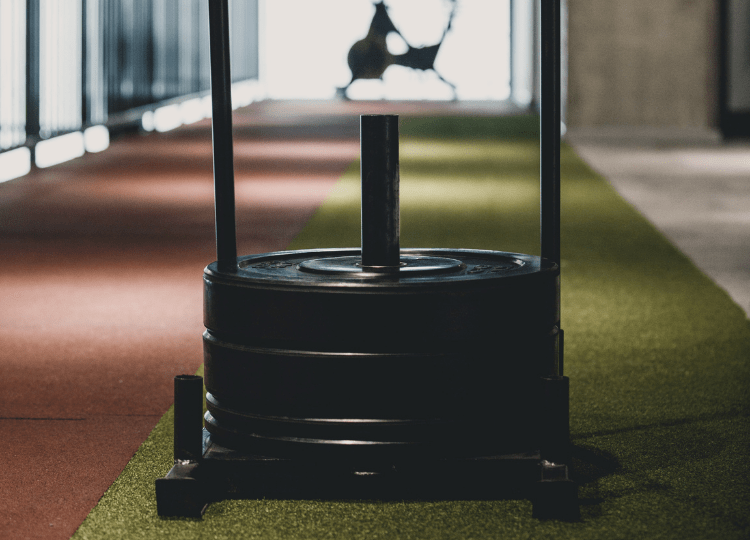
You need a bit of space to fully enjoy the benefits of a sled (and many gyms simply won’t have the space), but this equipment is great for functional workouts, especially for those who want to train the legs without doing common exercises like squats or lunges.
You can push and pull a sled… but you can also attach a battle rope to it, and pull it whilst sitting to turn it into an upper body workout.
Sleds usually allow you to simply load on barbell plates – so you can adjust the difficulty.
A lighter sled is better for more of a cardio focus workout, whilst a heavier sled will require more strength and power.
Sled Friendly Exercises:
- Forward Push
- Backward Pull
Sandbags
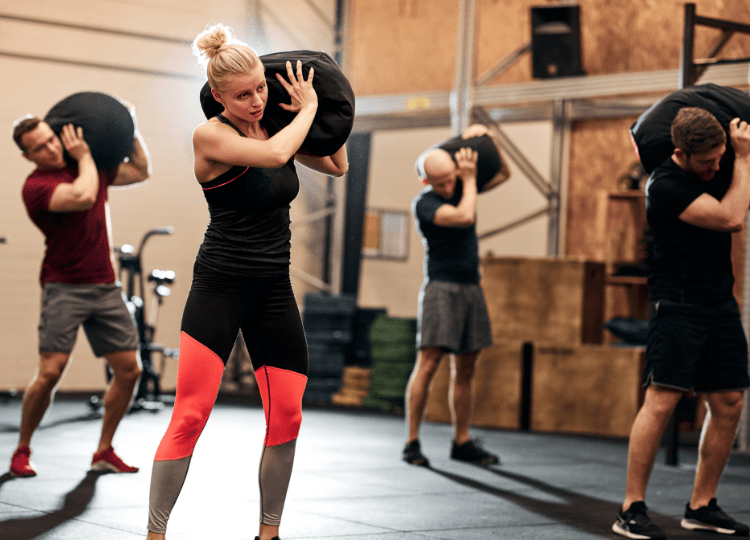
Sandbags are another versatile piece of equipment you may want to use in the gym.
Sandbags are quite self explanatory… they are literally bags (usually a cylindrical shape) filled with sand. These come in varying weights so you can select one most appropriate to your fitness level.
If you’re bored with, or simply don’t like using, the more common free weights like barbells and dumbbells, sandbags offer quite a different workout experience and you may find it brings some new energy to your workouts.
Sandbag Friendly Exercises:
- Squat
- Lunge
- Overhead Squat
- Deadlift
Bulgarian bags are also very similar to this as well. These are less common and better for grip and upper body functional strength.
Bottom Line
Free weights bring with them a whole host of benefits and are definitely worth using, whether you’re in the gym or exercising at home.
We like to mix things up and use different equipment to challenge our muscles in different ways. It’s not about comparing dumbbells vs barbells, for example, and trying to argue which one is best… because they all have their uses and benefits. A good workout plan will usually involve using a variety of free weights.
You may also want to use non-free weights, such as cable machines, leg press machine, etc, to supplement your workouts too.
Related Articles
How to Combine Yoga and Strength Training
